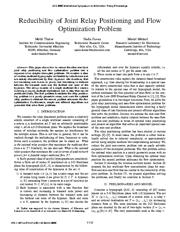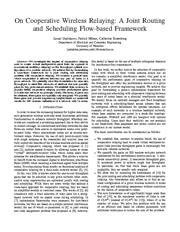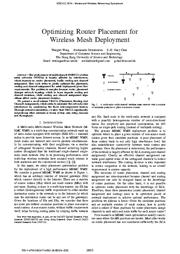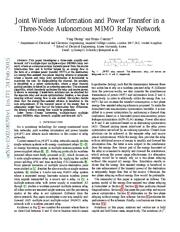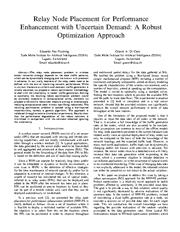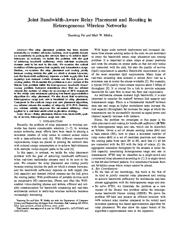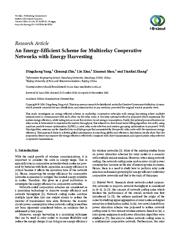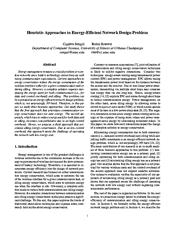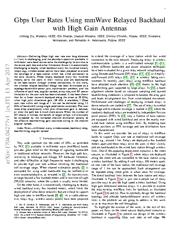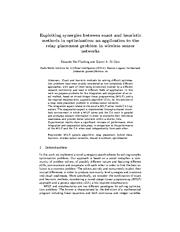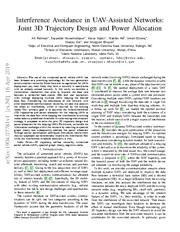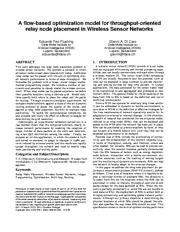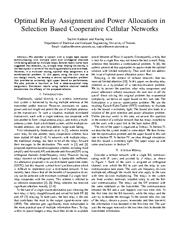The Internet Archive has a preservation copy of this work in our general collections.
The file type is application/pdf.
Filters
Reducibility of joint relay positioning and flow optimization problem
[article]
2012
arXiv
pre-print
This paper shows how to reduce the otherwise hard joint relay positioning and flow optimization problem into a sequence a two simpler decoupled problems. ...
The first problem formulates the relay positioning problem in a purely geometric sense, and once the optimal relay position is obtained the second problem addresses the flow optimization. ...
If Inequality (12) holds, then similar to the Max-flow problem the joint optimal relay positioning and min-cost flow optimization problem in Program (D) can be reduced to a sequence of decoupled problems ...
arXiv:1202.0835v1
fatcat:i6pfwjhlxvdgvf73zmt5j3766y
Reducibility of joint relay positioning and flow optimization problem
2012
2012 IEEE International Symposium on Information Theory Proceedings
This paper shows how to reduce the otherwise hard joint relay positioning and flow optimization problem into a sequence a two simpler decoupled problems. ...
The first problem formulates the relay positioning problem in a purely geometric sense, and once the optimal relay position is obtained the second problem addresses the flow optimization. ...
We reduce the hard joint relay positioning and flow (max-flow/min-cost) optimization problem to a sequence of simple decoupled problems. ...
doi:10.1109/isit.2012.6283026
dblp:conf/isit/ThakurFM12
fatcat:3t6iacd4cncjfofzqsnkvp3izi
On cooperative wireless relaying: A joint routing and scheduling flow-based framework
2012
2012 IEEE Global Communications Conference (GLOBECOM)
We achieve this by formulating a cross-layer framework for a joint routing and scheduling problem with cooperative relaying. ...
We investigate the impact of cooperative relaying used to create virtual multipoint-to-point links (as opposed to conventional multihop relaying) on the throughput optimal configuration of a wireless network ...
If no ISets with strictly positive reduced costs can be found, then the current solution is optimal. ...
doi:10.1109/glocom.2012.6503851
dblp:conf/globecom/ShabdanovMR12
fatcat:lr5esjk75fa5bc7asj2uwns4su
Optimizing router placement for wireless mesh deployment
2014
2014 IEEE International Conference on Communications (ICC)
This work seeks to jointly optimize the placement, routing and channel assignment for mesh deployment given flow requirements. ...
The problem is complex because router placement changes network topology which in turns impacts routing and channel decisions, while routing and channel assignment algorithms affect router placement decision ...
The contributions of this work are as follows: • Formulation of the joint optimization problem and its hardness analysis: We present the joint optimization problem for mesh deployment, which is to design ...
doi:10.1109/icc.2014.6883748
dblp:conf/icc/WongDC14
fatcat:t4usevo5ifhqtk47upr6jm63bm
Joint Mobility-Aware UAV Placement and Routing in Multi-Hop UAV Relaying Systems
[article]
2020
arXiv
pre-print
In order to exploit the benefits of UAVs as base stations or relays in a mobile network, a major challenge is to determine the optimal UAV placement and relocation strategy with respect to the mobility ...
To this end, we formulate the joint UAV placement and routing problem as a Mixed Integer Linear Program (MILP) and propose an approximation that leads to a LP rounding algorithm and achieves a balance ...
Acknowledgment The research of A. Gholami, N. Torkzaban and J.S. Baras, was partially supported by ONR grant N00014-17-12622 and by a grant from the Lockheed Martin Corporation. ...
arXiv:2009.14446v1
fatcat:a6b3gugbmbhfbgkurb4mokscyy
Joint Wireless Information and Power Transfer in a Three-Node Autonomous MIMO Relay Network
[article]
2015
arXiv
pre-print
An energy-flow-assisted two-phase relaying scheme is proposed, where a source and relay joint optimization is formulated to maximize the rate. ...
By diagonalizing the channel, the problem is simplified to a power optimization, where a relay channel pairing problem is solved by an ordering operation. ...
Hence, problem P1 reduces to a power optimization ...
arXiv:1502.06791v1
fatcat:hvp6izfs6zgnfmyzniqhqtbhwq
Relay node placement for performance enhancement with uncertain demand: A robust optimization approach
2013
International Symposium on Modeling and Optimization in Mobile, Ad-Hoc and Wireless Networks
Solving to optimality the resulting robust optimization problem would be extremely expensive in computational terms, therefore we propose a distinctive robustness measure aiming at dramatically reducing ...
The relay node placement problem in wireless sensor networks strongly depends on the data traffic patterns, which can be dynamically changing and not known with precision in advance. ...
Data flows and relay positions define the two sets of decision variables. The flow variable f ij denotes the amount of flow through link (i, j), expressed in flow units. ...
dblp:conf/wiopt/FlushingC13
fatcat:tdzn4lplbjg6xpmgr67v7pwmry
Joint Bandwidth-Aware Relay Placement and Routing in Heterogeneous Wireless Networks
2011
2011 IEEE 17th International Conference on Parallel and Distributed Systems
Compared to the uniform range and rate placement algorithm, our scheme reduces the number of relays by 25%-39%. ...
Extensive simulations show that our scheme reduces the number of relays by an average of 44% compared to the widely used minimum spanning tree based approximation algorithm for relay placement. ...
Our solution to HBSR places relay nodes iteratively and aggregates flows when the aggregation is predicted to reduce the number of relays, reducing relay number by an average of 44% compared to the widely ...
doi:10.1109/icpads.2011.76
dblp:conf/icpads/PeiM11
fatcat:jxayb7lsbfgg5iilwc756rxjma
An Energy-Efficient Scheme for Multirelay Cooperative Networks with Energy Harvesting
2016
Mobile Information Systems
Secondly, using quantum particle swarm optimization (QPSO), a joint relay node selection and session grouping optimization is proposed. ...
This approach leads to a better global optimization in searching ability and efficiency. ...
Acknowledgments This work was partly supported by the National Natural Science Foundation of China (61461029 and 61561032), the Natural Science Foundation of Jiangxi Province (20114ACE00200, 20161BAB202043 ...
doi:10.1155/2016/5618935
fatcat:zcunx63atne7ffum74mi2h3kbi
Heuristic Approaches to Energy-Efficient Network Design Problem
2007
27th International Conference on Distributed Computing Systems (ICDCS '07)
., for data and control overhead) and idling. This problem can be expressed as an energy-efficient network design problem, which is, not surprisingly, NP-hard. ...
Current approaches to energy conservation reduce the energy consumption of the wireless interface either for a given communication task or during idling. ...
We simulate the following protocols: proactive joint optimization (DSDVH-ODPM), reactive joint optimization with and without traffic rate information (DSRH-ODPM(rate) and DSRH-ODPM(norate)), and power ...
doi:10.1109/icdcs.2007.114
dblp:conf/icdcs/SengulK07
fatcat:3jbxsckt6neg7juhmmfnbyk4xy
Gbps User Rates Using mmWave Relayed Backhaul With High-Gain Antennas
2017
IEEE Journal on Selected Areas in Communications
In this work, the wireless relayed backhaul design has been formulated as a topology-bandwidth-power joint optimization problem, and the influence of path loss, angular spread, array size, and RF power ...
The user rates drop precipitously when joint directional gain is reduced, or when the path loss is much more severe. ...
This is done by focusing on the dual problem and by using the flow network to decouple the backhaul topology and bandwidthpower constraints for each relay node. ...
doi:10.1109/jsac.2017.2686578
fatcat:77aoj4a3d5gtbdtt2xduv5dwoe
Exploiting Synergies Between Exact and Heuristic Methods in Optimization: An Application to the Relay Placement Problem in Wireless Sensor Networks
[chapter]
2014
Lecture Notes of the Institute for Computer Sciences, Social Informatics and Telecommunications Engineering
the solution of a relay node placement problem in wireless sensor networks. ...
Exact and heuristic methods for solving difficult optimization problems have been usually considered as two completely different approaches, with each of them being extensively studied by a different research ...
In the following, we measure τ in terms of flow units, f unit , expressed as bytes/sec. Data flows and relay positions define the two sets of decision variables. ...
doi:10.1007/978-3-319-06944-9_18
fatcat:j5gxd4htw5enxi24revfvmpabi
Interference Avoidance in UAV-Assisted Networks: Joint 3D Trajectory Design and Power Allocation
[article]
2019
arXiv
pre-print
An alternating-maximization strategy is proposed to solve the joint 3D trajectory design and power allocation for the relaying UAVs. ...
Our primary goal is to optimize the three-dimensional (3D) trajectories and power allocation for the relaying UAVs to maximize the data flow while keeping the interference to existing nodes below a predefined ...
As a follow up work for [8] , we studied the optimal position planning of UAV relays considering both the existence of a single UAV and multiple UAVs between the transmitter and the receiver, which coexist ...
arXiv:1904.07781v1
fatcat:rnhhebldkfdodpw2hoi42wfn6q
A flow-based optimization model for throughput-oriented relay node placement in wireless sensor networks
2013
Proceedings of the 28th Annual ACM Symposium on Applied Computing - SAC '13
the network and used to modify relay node positioning and routing paths. ...
Additional relay nodes can be placed with the aim of optimizing overall network performance in terms of data throughput. ...
In [23] , the authors studied the joint problem of placing relay nodes and scheduling node transmissions in the presence of controlled mobility. ...
doi:10.1145/2480362.2480482
dblp:conf/sac/FlushingC13
fatcat:bzvqg7daxrb53pkeq5appnclzi
Optimal Relay Assignment and Power Allocation in Selection Based Cooperative Cellular Networks
2009
2009 IEEE International Conference on Communications
., a single relay helping the source, is the best option in terms of the resulting complexity and overhead. However, in a multiuser setting, optimal relay assignment is a combinatorial problem. ...
We also provide a heuristic to find a close-to-optimal relay assignment. Simulation results using realistic channel models demonstrate the efficacy of the proposed scheme. ...
In this paper we have developed an optimization framework to solve the problem of joint selection and power allocation. The optimization problem uses the achievable sum rate as its figure of merit. ...
doi:10.1109/icc.2009.5199285
dblp:conf/icc/KadloorA09
fatcat:myeruvs5vbd45ljxq3kjyzxb2y
« Previous
Showing results 1 — 15 out of 16,970 results

